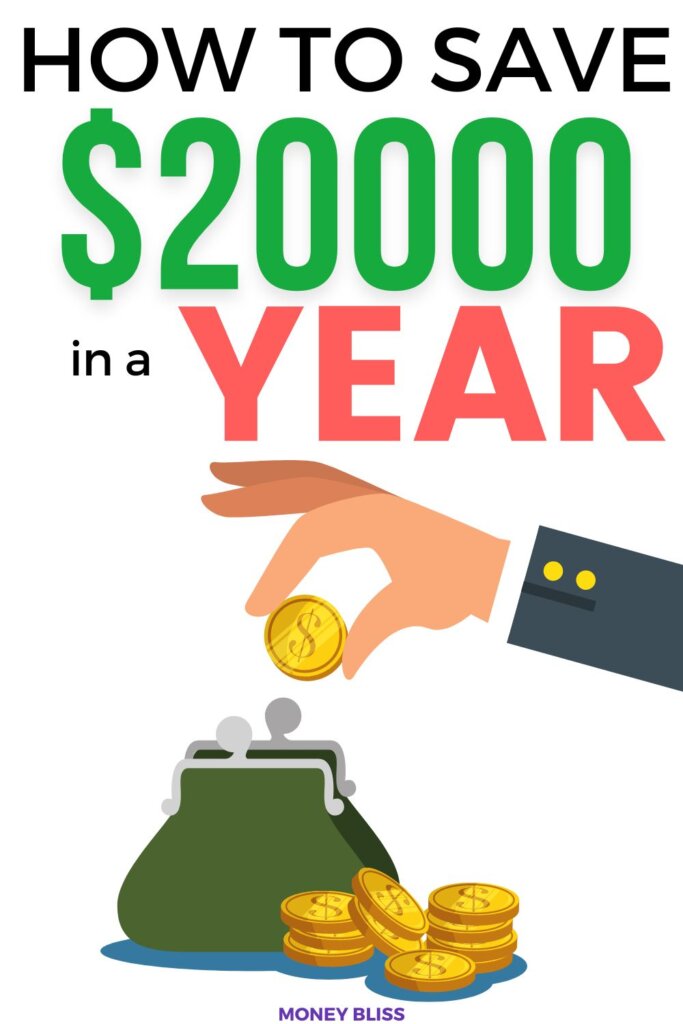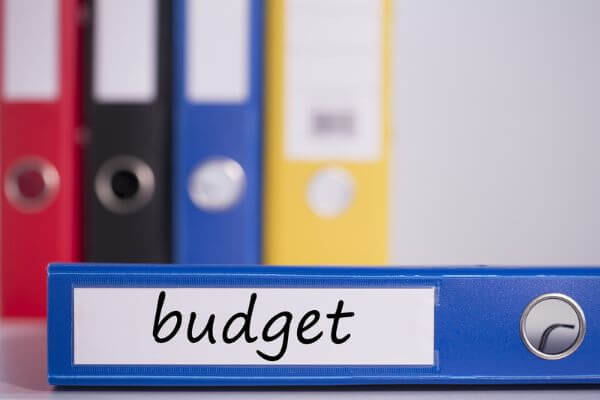How to Save 20000 in a Year: 10 Ways to Master this Savings [Challenge]
Inside: This guide has easy tips to help you achieve your savings challenge goals. By following these tips, you’ll be on your way to mastering how to save 20000 in a year!
A lot of people think that saving money is difficult and time-consuming. Generally, they don’t know where to start or how to save thousands on a budget.
In this article, I’m going straight into my tips for saving $20K in the next year without too much effort!
So many of my readers have completed how to save 10000 in a year, that I had to up the ante for everyone.
Simply put, saving money is money you don’t spend.
That unspent money is saved for a future purchase.
So, let’s knock down the barriers that saving money is no fun. You just don’t get to spend the money now.
But, you will.
And that is when saving money feels amazing! You hit your saving goal. That is a win!
The time is yours to learn how to save 20000 in a year!

Is it possible to save 20000 a year?
Saving money can be challenging, but saving $20000 in a year is possible if you are dedicated to your personal finances.
To save money, you must follow a plan which includes spending less, making more money, and focusing on your money goals. Plus automating your savings will make it easier.
This post may contain affiliate links, which helps us to continue providing relevant content and we receive a small commission at no cost to you. As an Amazon Associate, I earn from qualifying purchases. Please read the full disclosure here.
Why is it important to save money?

Saving money is important for many reasons, and we will detail some of those in a minute.
1. Grants financial independence and time freedom
The main reason is saving money also allows for more financial stability and freedom. That helps you sleep at night.
Saving money allows people to live a comfortable life without depending on others – knowing how to become financially independent is important.
When people have enough money saved up, they can live without worrying about their finances. They can also use the money they save to pursue their dreams.
2. A cushion in case of emergencies
This buffer can help you weather tough times and come out stronger on the other side. When you have a financial plan, you are making a conscious decision to be responsible with your money and set yourself up for success down the road.
3. Allows for experiences you otherwise couldn’t have

Saving money is important because it gives you the opportunity to do things that you wouldn’t be able to do if you were spending all of your money. This could include traveling to new places, trying out new experiences, or spending money to learn a new skill.
4. Able to retire comfortably
Saving money is one of the most important things you can do for your future. It allows you to live a comfortable life in retirement without having to worry about finances.
This is especially important because people are living longer and need more money to support themselves during their golden years.
How much do I need to save to get 20000 in a year?

If you want to save $20,000 in a year, you need to break it down into smaller goals.
Each month you must save $1,666 a month.
On a weekly basis, you must save $385 a week. Biweekly paycheck, then you must save $770 from each paycheck.
Looking for easier biweekly money saving challenges, we got you covered!
How to save 20000 in a year?

The best way to save $20k in 12 months is to make it easier and break the goal down into smaller ones that are more manageable.
This makes it easier to stay on track and eventually achieve your savings goals.
Step 1: Determine your monthly net income
In order to save $20,000 in a year, you need to know your monthly net income.
To calculate this, start by finding out your gross income. This is the total amount of money you make in a month before any taxes or deductions are taken out.
From there, subtract any necessary monthly expenses such as rent, car payments, and insurance premiums. What’s left is your monthly net income.
Step 2: Set a savings goal
The first step to saving money is to set a goal. You must decide how much you are planning to save per month, per week, or per paycheck.
This will help you focus on how much you need to save and keep you motivated.
Also, accountability is key to setting and achieving savings goals. If possible, find someone who will hold you accountable such as a friend or family member.
Step 3: Automate your savings

To make sure you stay on track, set up an automatic transfer to your savings account each week. This means setting up a transfer from your checking account to your savings account each week.
This will help you reach your goal of saving more money each week more easily.
For this 20k money saving challenge, it is highly recommended to open up a separate bank account you won’t see often or a brokerage account. Set it and forget.
Step 4: Invest your money
Investing your money is a long-term process and requires patience. This compound interest is powerful and helps you accumulate more money over time.
However, it is possible to make wise investments that will grow over time and help you to reach your savings goal. For a simple approach to investing, I highly recommend this book.
Even if you are not comfortable putting the money into the stock market, I would highly recommend finding a saving account that pays over 1%. A small return on your money is better than none.
Step 5: Live below your means
If you want to save money, you need to be aware of your spending patterns.
Take a look at where you are spending the most money and see if there are any areas where you can cut back.
For example, if you eat out frequently, try cooking at home more often to save money. Or if your rent takes up a large chunk of your income, it will be difficult to save much each month. Ideally, you should aim to bring home enough each month so that you have some leftovers to put into savings.
If your goal is to save $20,000 net a year, this means living below your means and making wise financial choices with your spending.
Step 6: Make extra money

For most people, making more money is a key part of saving $20,000 in a year.
There are many ways to make extra money, and it will depend on your skills and interests. You could start by looking into ways to make more money through your job or by starting a side hustle. You could also look into investing your money or earning passive income.
Whatever route you choose, remember that it takes time and effort to save money, but it is worth it in the end!
Step 7: Track your progress
Track your progress by using an app to help you stay on budget. This will allow you to keep track of your spending and identify any areas in which you may need to adjust your budget.
If you happen to miss a week, don’t worry- simply pinpoint what happened and how you can fix it so that it doesn’t happen again.
Here are the best budgeting apps available today.
Bonus: Use a savings challenge
A savings challenge is a plan to save money over time, usually with a specific goal in mind. challenges can be flexible, allowing you to save more or less depending on your budget.
It can be helpful to set a weekly savings goal in advance so that you don’t have to adjust it every week.
Here at Money Bliss, we are known for our popular money saving challenges, so make sure to stick around and you will save more money than you initially imagined.
Best ways to save 20k

Here are some ways to save 20k in a year, but you should keep your own unique budgeting needs and savings strategies in mind when planning out your personal saving plan.
This is just a list of ways you can try to save money, but there are no guarantees that these methods will work for everyone.
Idea #1 – Start With Your Goal
It is important to have a specific goal in mind when saving money. This will help to keep you motivated and on track. Your goal should be SMART- specific, measurable, attainable, relevant, and time-bound.
Fill in this blank…
My reason to save 20000 in a year is ____________.
Your answers could include a downpayment on a house, a new car, college expenses, or retirement. That is your goal – your why to save.
Idea #2 – Seek Inspiration & Stories
When looking for financial advice, it is important to ask people you trust for their opinion and to listen to a variety of different financial stories in order to gain inspiration.
Friends and family can be great resources, especially if they have experience with personal finance. Additionally, many independent popular personal finance books are a great start.
Find motivation to keep your saving journey a success.
Idea #3 – Pay Yourself First & Transfer Money
Saving money means not spending it. This can be difficult, but there are a few ways to make it easier.
It is important to learn how to pay yourself first. Take away the temptation to spend the money.
Setting up an automatic transfer is a great way to save money on a regular basis. This will ensure that you always have some money going into your savings account, even if you forget to do it manually.
Idea #4 – Promise to Budget

Tracking expenses allows you to see where your money is going and how you can adjust your budget in order to save money. It’s important to be mindful of your spending habits and make small adjustments as needed so that you can stick to your budget.
It is possible to save 20,000 dollars by following a budget and sticking to it.
Idea #5 – Invest Money
The best way to save money is to invest it regularly.
You should choose an amount that you can afford to invest even in more expensive weeks. Set up an automatic transfer to your savings account so you don’t have to think about it.
This will help you save money in the long run.
Idea #6 – Proper Money Management
Money management is key to having a healthy financial future. By knowing your spending weaknesses and avoiding them, you can prevent yourself from overspending.
This means having a budget to keep track of your income and expenses, so you can make more informed choices about how you spend your money.
It’s also important to mix up your spending – if you have one or two big expenses each month, it can be tough to manage your money wisely. By spreading out your spending, you’ll be less likely to get bogged down by large payments.
Idea #7 – Maybe DIY vs Outsourcing tasks
One way to reach your goal of becoming financially independent sooner is by saving money. Reviewing your budget every fortnight and reconsidering the tasks you outsource can help you do this.
For example, we just paid $70 for our sprinkler system to be blown out. We are over the cost, so thanks to a new air compressor and youtube, we plan to do DIY going forward. https://amzn.to/3Ftitk7
Other costly outsourced tasks include housekeeping, lawn maintenance, or simple home projects.
Idea #8 – Know Your Spending Traps

Spending traps are areas where you tend to overspend. They can be due to a variety of factors, including subscription fees, impulse buying, and not planning ahead. You can avoid spending traps by being mindful of your spending habits and budgeting accordingly.
For my friend, her spending trap was going to Target when her husband had to work late and then buying takeout on the way home. Now, she flipped it to packing a picnic dinner and heading to a park.
- Use a budgeting app or track your transaction history to find areas where you are overspending. This will help you identify subscriptions that you can cancel, free trials that you can take advantage of, and ways that you can reduce impulse buying.
- Plan ahead and know your triggers. This means knowing what you need before you go shopping and only buying items that are on sale or in season. Planning ahead will help you save money on groceries and other items.
A simple way to cut a lot out of your spending.
Idea # 9 – Replace a costly habit
It’s often said that the quickest way to save money is to challenge yourself to cut out your most expensive habit. And while it may be tough, it can be well worth the effort in the long run.
If you’re looking for ways to save, consider replacing some of your more costly habits with cheaper alternatives.
Making a list of your expensive habits is the first step to saving money. Once you know how much each habit costs you, you can start looking for ways to reduce that amount. Maybe you can cut back on eating out or find a less expensive cell phone plan. Whatever the case, finding ways to save money will help you reach your financial goals.
Idea #10 – House share your place
House sharing can help you save money by reducing your living expenses. When you share a house, you split the cost of rent, utilities, and other bills with your roommates.
This can save you a significant amount of money each month. In addition, house sharing can reduce your transportation costs if you live close to your roommates or in an area with good public transportation.
Idea #11 – Avoid Credit cards

Cut up your credit cards and only carry one in an emergency.
When you use a credit card to make a purchase, you are essentially borrowing money from the credit card company. This can lead to expensive interest rates and fees if you do not pay your balance in full each month.
If you do use credit cards, make sure to pay the balance in full each month to take advantage of those credit card rewards.
Idea #12 – Celebrate differently
Celebrations, such as birthdays, Christmas, and even happy hour each week, can be expensive. One way to save money on celebrations is to think about practical, cheaper gifts or different ways to celebrate.
Here are a few ways to save money when celebrating:
- Have the celebration at home instead of a restaurant or bar.
- Make your own food and drinks instead of buying them.
- Choose less expensive activities, like going for a walk or playing games.
- Maybe even implement a no gift Christmas.
If you want to save money on them, try to think of practical consumable gifts that the person can use. For example, a gift card or a book are both cheaper than buying something frivolous.
Idea # 13 – Don’t buy new clothes for a year
If you’re trying to save money, one way to do it is to pledge not to buy any new clothes for a year.
This can be a difficult challenge, but it can lead to significant financial savings. Not buying clothes for a year means you won’t be spending money on items like shirts, pants, dresses, and shoes. Instead, you’ll need to rely on the clothes you already have in your closet.
This can be a good opportunity to get creative with your wardrobe and mix and match items in new ways. You may also want to focus on repairing any clothes that are damaged instead of buying new ones.
Additionally, cutting back on other expenses like massages, pedicures, and manicures can also help you save money.
Idea #14 – Be strategic about your meals

Eating out can be expensive, so cooking at home more often can save money on meals.
Cutting out three restaurant visits a week will result in $6,000 in easy savings over a year. To save even more money, cut back on discretionary expenses like dining out.
Meal planning doesn’t have to be hard, and it can save you money in the long run. Plan your meals around what you have on hand, what’s on sale, and what you’re in the mood for. This way, you’ll avoid spending too much at restaurants or on take-out.
Idea #15 – Invest in Yourself
One of the best things you can do for your future is to invest in yourself. The more you learn and develop your skills, the better your future will be.
Investing in yourself will give you the opportunities you need to achieve your goals. You can learn new things and improve your skills through education, training, and experience.
This will help you find a job that is right for you and give you the opportunity to make a real difference in your field. Plus the chance to make more money!
Idea # 16 – Switch your insurance plan
To save money on your insurance, look into changing your insurance plan.
This could mean finding a new insurer with better rates or raising your deductible. You could also check your home and auto insurance rates online to see if you can get a better deal.
The amount of money you save will depend on the type of insurance plan you change to. Just make sure you are covered – don’t drop too much coverage.
Idea #17 – Solidify your Plan & Stick to It
Saving money can be tough, but it’s a lot easier if you have a plan. A written plan will help you get nitty gritty with your spending and figure out where you can cut back. Having a solid savings plan in place will give you the peace of mind to know that you’re covered in case of an emergency.
This saving plan is important for your financially stable future.
Every penny counts, so start saving today!
Idea #18 – Generate Additional Income

There are many ways to make more money in order to save the $20,000 you need in the next year. If you are willing to hustle and be creative, there are plenty of opportunities out there for you.
You could find a part-time job, start a side hustle, or even sell some of your belongings. The most important thing is that you take action and get started today!
In fact, learning how to make money online for beginners is a hot topic.
Generating an extra $1,000 per month can help you reach your financial goals more quickly. Whether it’s to pay off debt, save for a down payment on a house, or just have some extra money in the bank, making an extra $1,000 each month can make a big difference.
Idea # 19 – Grit and determination
Saving money can be difficult, but it’s important to have grit and determination to achieve your goals.
Setting specific, quantifiable goals for yourself so that you can track your progress and develop a sense of accomplishment as you save money.
It is easier to say “no” to spending money when you know your why to save money. Keep visualizing your goal and stay on track.
Idea # 20 – Be Patient & Have Faith
It’s important to remember that saving $20,000 in a year is not going to happen overnight. It will take time and patience to reach your goal, so don’t get discouraged if you don’t see results right away.
Furthermore, have faith in yourself that you can reach your goal of saving $20k within one year. If you believe in yourself and stay focused on your goal, anything is possible!
Just keep at it and eventually, you’ll get there.
What are the 10 simple tips to complete this savings plan?

By taking these simple steps, you can help reduce your overall expenses and have more money left over to save or spend.
1. Use a budgeting app or transaction history to find opportunities to save money.
2. Cancel subscriptions that are not worth the money with Billshark or Trim.
3. Free trials can help you test out a subscription before you buy it.
4. Planning your supermarket shop can help you save money.
5. Checking the clearance section first – online and in-store – to score the best deals.
6. Plan how much money you will spend before you go shopping.
7. Know your spending weaknesses and avoid them.
8. Buy things in bulk when they are on sale.
9. Use coupons to save money online – I like Rakuten.
10. Make your own products like homemade shampoo, cosmetics, etc.
List of benefits for saving 20000

The $20,000 saving challenge gives you a clear target and plan that can help you develop new savings habits.
- The $20,000 saving challenge gives you a clear target and plan: The goal is clear and concise, so you can set your sights on it and work towards it.
- You will end up with new savings habits: By completing the challenge, you may develop some new savings habits that will help you build a bigger balance or invest your wealth.
- If you miss a week of the challenge, don’t sweat it: If for any reason one week of the challenge falls during your busy schedule, don’t worry – just pinpoint what happened and how to deal with it then keep going.
- You can adjust your goal if needed: If your original goal wasn’t sufficient enough to save money for the month, feel free to adjust it accordingly by transferring saved money from other weeks onto this week’s sheet (or even throughout the entire month).
The benefits are immense when learning how to save money.
FAQs
Are you Ready for this 20k Savings Challenge?

Saving money can be a challenge, but it doesn’t have to be impossible. You wanted to save for a reason so stick with that to keep you motivated.
By following the tips in this post, you’ll be on your way to mastering this money saving challenge.
At the end of the challenge, you may have new savings habits to help you build a bigger balance or invest some of your wealth. However, even if you don’t continue saving after the challenge is over, simply completing it will give you a sense of accomplishment and may motivate you to save more in the future.
There are many different ways to set and achieve savings goals but the important thing is getting started. Saving money can be a difficult task, but it is possible to save 20000 in a year by following a budget and investing your money wisely.
Accountability is key to success with savings challenges.
So what are you waiting for? Start saving today!
Did the post resonate with you?
More importantly, did I answer the questions you have about this topic? Let me know in the comments if I can help in some other way!
Your comments are not just welcomed; they’re an integral part of our community. Let’s continue the conversation and explore how these ideas align with your journey towards Money Bliss.


